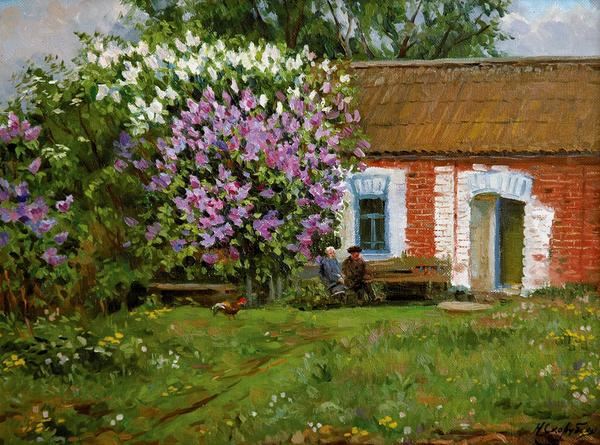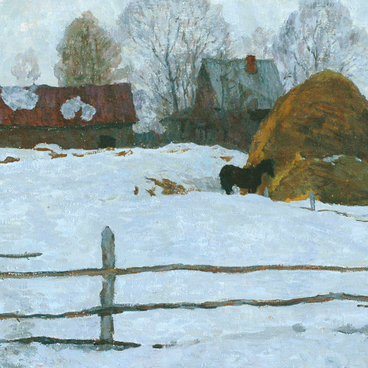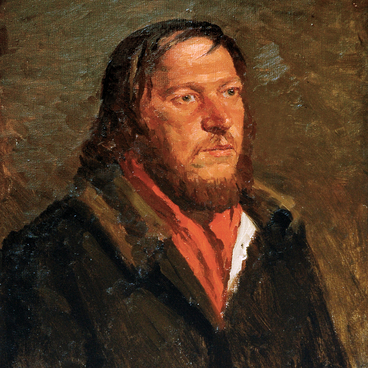The work of Nina Skorubskaya conveys many features of 20th century Soviet painting such as a desire for realism and authenticity, the life of the Soviet people, and, of course, landscapes.
The painting ‘House of Veteran A. A. Vinokurov in the village of Slanskoe’ is very recognizably the work of the artist. It contains all of Skorubskaya’s favourite motifs and techniques. It is a picture of the laid-back country life: a well-kept house, a rooster walking around the courtyard, an elderly couple comfortably seated on a bench under a lilac bush. The artist’s main focus is precisely the landscape. One third of the painting is a picturesque meadow with flowers in the foreground. Two large colour spots – lilac bushes and a red brick house with white casings — attract the eye. The viewer does not immediately notice the two people sitting on the bench.
A love for painting, and specifically for landscapes, was born in the artist during her studies in Samarkand. The country’s art schools were evacuated there during the war. At that time Skorubskaya was studying at the Institute of Decorative and Applied Arts in the department of porcelain. It was then that the artist Robert Falk, one of Skorubskaya’s teachers in Samarkand, recommended that she pay more attention to landscape painting.
Upon graduation, she turned her back on applied arts and continued her career as a painter. This was facilitated by the fact that since 1948, Skorubskaya often visited and worked at the Academic Dacha, where many masters of the Union of Russian Artists would come together for creative workshops. In particular, there was Sergei Gerasimov, well-known to Skorubskaya even in Samarkand. He worked in a nearby workshop and became one of her primary mentors in open-air painting. Interaction with him and many other experienced artists helped Skorubskaya determine her future path and develop her own style.
Skorubskaya came to the village of Slanskoye, where the painting was made, with her husband, artist Nikolai Sysoev. It was the place where he was born, began his career, and where he often returned to later in life. Not far from the village, in the settlement of Leo Tolstoy, Sysoev founded an art gallery in 1987, later named after him. A significant contribution to the creation of this museum was made by Nina Skorubskaya. More than 50 of her paintings were included in the gallery’s collection.
The painting ‘House of Veteran A. A. Vinokurov in the village of Slanskoe’ is very recognizably the work of the artist. It contains all of Skorubskaya’s favourite motifs and techniques. It is a picture of the laid-back country life: a well-kept house, a rooster walking around the courtyard, an elderly couple comfortably seated on a bench under a lilac bush. The artist’s main focus is precisely the landscape. One third of the painting is a picturesque meadow with flowers in the foreground. Two large colour spots – lilac bushes and a red brick house with white casings — attract the eye. The viewer does not immediately notice the two people sitting on the bench.
A love for painting, and specifically for landscapes, was born in the artist during her studies in Samarkand. The country’s art schools were evacuated there during the war. At that time Skorubskaya was studying at the Institute of Decorative and Applied Arts in the department of porcelain. It was then that the artist Robert Falk, one of Skorubskaya’s teachers in Samarkand, recommended that she pay more attention to landscape painting.
Upon graduation, she turned her back on applied arts and continued her career as a painter. This was facilitated by the fact that since 1948, Skorubskaya often visited and worked at the Academic Dacha, where many masters of the Union of Russian Artists would come together for creative workshops. In particular, there was Sergei Gerasimov, well-known to Skorubskaya even in Samarkand. He worked in a nearby workshop and became one of her primary mentors in open-air painting. Interaction with him and many other experienced artists helped Skorubskaya determine her future path and develop her own style.
Skorubskaya came to the village of Slanskoye, where the painting was made, with her husband, artist Nikolai Sysoev. It was the place where he was born, began his career, and where he often returned to later in life. Not far from the village, in the settlement of Leo Tolstoy, Sysoev founded an art gallery in 1987, later named after him. A significant contribution to the creation of this museum was made by Nina Skorubskaya. More than 50 of her paintings were included in the gallery’s collection.



